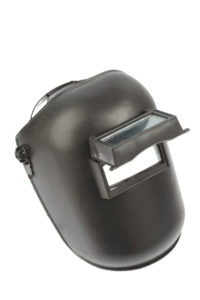Workplace eye injuries are staggeringly common, affecting more than 2,000 people in the United States each year. Even more surprising is that an approximate 90% of them could have experienced less severe symptoms, or even prevented the injury altogether, by employing protective eyewear while performing work activities.
The Bureau of Labor Statics conducted a survey of workers that sustained injuries on the job; 3 in 5 reported that they were not even wearing eye protection at the time of their accident. Reason being? They didn’t know it was required for their situation.
Who is at risk of getting injured on the job?
No job is completely safe 100% of the time. However, when it comes to hazards that require personal protective equipment (PPE) such as eye protection, there are certain occupations that present higher risk of injury due to the nature of the work and environment it is performed in. Some examples of fields that can create higher risk of eye injury include manufacturing, electrical work, welding, and auto repair; workers here commonly run the risk of sustaining injuries such as eye cuts or scrapes due to entry of a foreign object. Additionally, there are occupations that present the risk of coming in contact with infectious diseases that can be passed through the eye, such as laboratory technicians and healthcare workers.
What are the hazards to keep an eye out for?
OSHA outlines five types of hazards that can be combated with face and eye protection: impact, heat, chemicals, dust, and optical radiation.

Impact:
Think about all the sawdust that is produced when a carpenter guides a slab of wood over a table saw. Wood particles fly around haphazardly until finally finding a spot to rest somewhere in the carpenter’s work space. This is an example of an impact hazard, which also includes other flying objects such as dirt and larger particles or fragments of materials. Although usually quite small, if things like this enter into your eye, it can cause anything from a minor annoyance to a serious puncture.
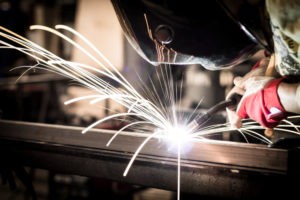
Heat:
A welder working alongside a blazing hot blow torch certainly has reason to wear eye (and face) protection to keep him/her from getting seriously burned. Any other workplace activities that include extremely high temperatures, molten metal, fire, or sparking, warrant eye protection. Additionally, face protection is often required as an additional safeguard, many of which contain special heat-resistant and anti-fog materials. In the case of heat hazards, it is extremely important to know the intensity of the heat and types of splashes/sparks that could come in contact with the workers.

Chemicals:
Any professional working with chemicals should be aware of any hazards of direct contact with chemicals and take all necessary precautions to prevent it; however, improper selection of eye protection can sometimes lead to those efforts being in vain. Chemicals can reach the eyes in the form of vapors, fumes, or mists, which can easily slip through any gaps in improperly chosen or fitted PPE. Injuries from chemical exposure can be extremely serious.
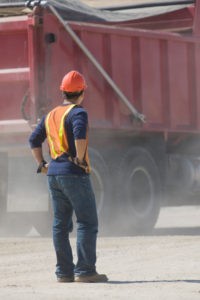
Dust:
Dust is quite literally everywhere, and is impossible to avoid while performing work activities such as woodworking or buffing. Although anyone can be a victim of an eye injury caused by dust, contact lens wearers are more susceptible. It must also be noted that in dusty situations, your PPE (OSHA says that goggles are the only effective type in dusty environments) must be kept clean, as dust can easily affix itself to eyewear.
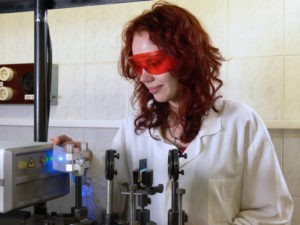
Optical Radiation:
Workers that handle lasers (or comparable equipment) may be at risk of exposing their eyes to high heat, ultraviolet, infrared, and reflected light, which can be extremely dangerous and cause serious and irreversible damage to the eye. Again, when exposed to optical radiation it is important to know the highest intensity that may be presented during work operations so proper PPE can be chosen in accordance.
Keep in mind that it is entirely possible, depending on the field/industry, that more than one of these hazards will be presented. A thorough hazard assessment must be completed to determine what exactly workers might be exposed to, how intense it could be – including what could be presented in an emergency situation. Workers should be able to go to their supervisor or health and safety department to be made aware of what PPE is necessary and required for their job.
Let’s talk regulations. How do you stay compliant with OSHA?
OSHA states “eye and face protection must be provided whenever necessary to protect against chemical, environmental, and radiological hazards or mechanical irritants.” The general requirements for eye and face protection can be found in 29 CFR 1910.133. Basically, this regulation states that it is the responsibility of the employers to ensure that all workers are provided with proper eye or face protection when exposed to the hazards mentioned above. This includes making sure that side protection is provided as needed, as well as filtered lenses in cases where protection from injurious light radiation is necessary. As previously mentioned, hazard assessments must be conducted to determine what workers may come in contact with.
Now we know why it is necessary to have eye protection in the workplace, but there are a number of different types to consider, each one being suited to certain hazards.
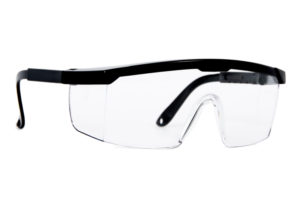
Safety Glasses: Basic safety glasses can come in either prescription or non-prescription, and are usually a subtle choice in PPE although they are much sturdier than run-of-the-mill eye glasses. They are most commonly used with basic workplace hazards like dust or other airborne particles, deeming them fairly impact resistant. Higher levels of protection can be achieved by obtaining a wraparound style or safety glasses with side shields. They are very versatile, and are available in glass, plastic, polycarbonate, and Trivex materials, each meeting or exceeding minimum requirements set in place by the American National Standards Institute (ANSI).
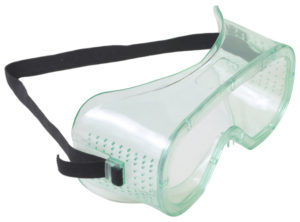
Goggles: Goggles may be used in the same applications as safety glasses, but can also provide protection against chemical exposure and dust. They are bulkier than safety glasses because they form around your face, but they can be worn over prescription glasses or contact lenses.
Face Shields and Helmets: When workers are exposed to chemicals, heat, or bloodborne pathogens, it may be necessary to provide face shields. Helmets are used by welders and others that work with molten metals. Face shields and helmets are a second line of defense. It is necessary to use them in conjunction with goggles or glasses.
There are variations on each type of eye protection, and it is of the utmost importance that you protect your workforce from the highest level and severity of exposure they may encounter on any given day; including in a case of emergency. Even with eye protection set in place, always remember that it not the one and only way to protect your workforce from said hazards. Whenever possible, they should be eliminated or lessened by setting in place engineering controls such as machine guards or work screens.
Sources:
American Optometric Association. Protecting Your Eyes At Work
Centers for Disease Control and Prevention. Eye Safety Checklist
Industrial Safety & Hygiene News. Five Common Eye Hazards
National Safety Council. Protecting Your Eyes from Injury
US Department of Labor. Occupational Health & Safety Administration, Selecting PPE for the Workplace
US Department of Labor. Occupational Health & Safety Administration, Eye and Face Protection eTool


